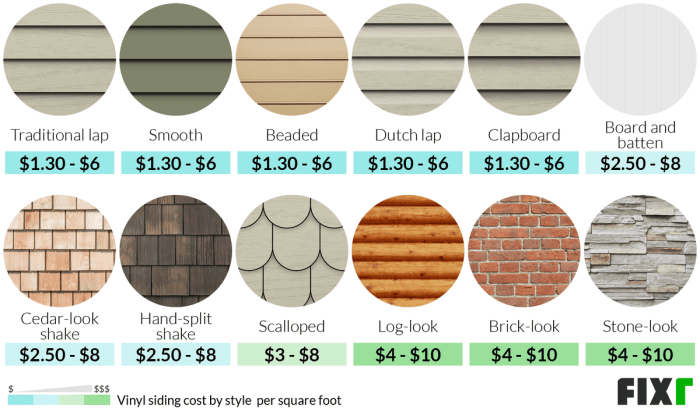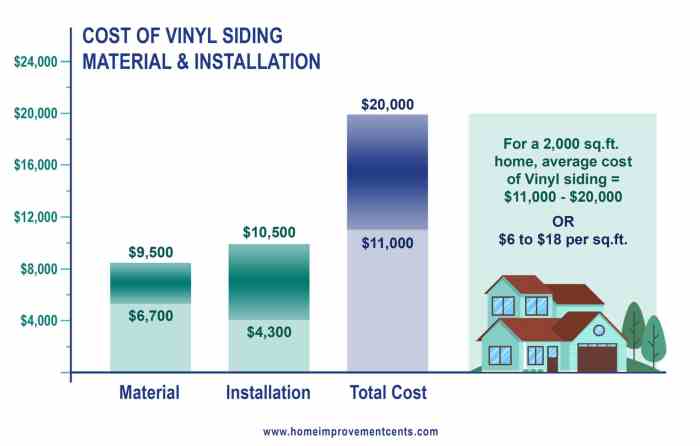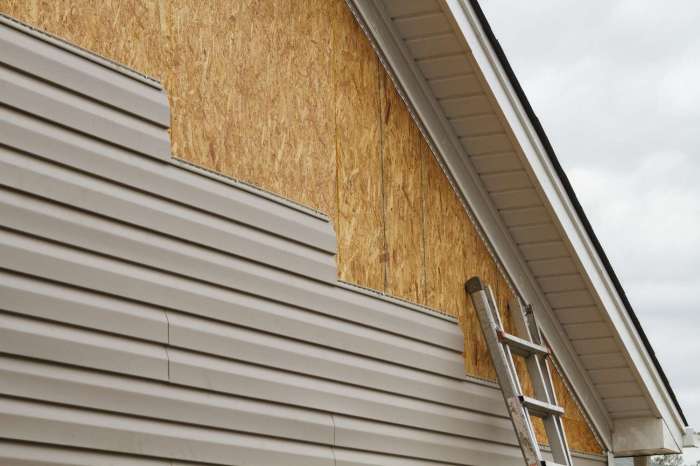Vinyl siding prices aren’t one-size-fits-all. Understanding the factors influencing cost is crucial for homeowners planning a renovation. From material quality and labor rates to project complexity and brand choices, numerous variables impact the final price tag. This guide unravels the intricacies of vinyl siding costs, helping you make informed decisions.
We’ll explore different vinyl siding types, their associated price ranges, and provide practical tips for estimating costs for various projects, from small residential homes to larger commercial structures. Learning to navigate the nuances of contractor selection and bid review is equally vital for a successful project, and we’ll cover those essential steps too. By the end, you’ll have a solid grasp of what to expect when budgeting for your vinyl siding project.
Factors Influencing Vinyl Siding Prices

Several key factors interact to determine the final cost of vinyl siding installation. Understanding these elements allows homeowners to make informed decisions and budget effectively for their projects. These factors range from the inherent properties of the siding material itself to the complexities of the installation process and regional variations in labor costs.
Material Quality Impacts on Vinyl Siding Costs
The quality of vinyl siding directly correlates with its price. Higher-quality siding typically features thicker vinyl, improved UV resistance, and enhanced durability. For example, a premium siding with a thicker gauge (e.g., .046 inch) will offer superior impact resistance and longevity compared to a thinner gauge (.040 inch) option, justifying a higher upfront cost. These higher-grade materials often come with longer warranties, mitigating long-term replacement expenses. Features like realistic wood grain textures or enhanced colorfastness also contribute to higher price points.
Regional Labor Cost Variations and Their Impact
Labor costs significantly influence the overall project expense. Metropolitan areas with higher average wages tend to have more expensive installation services than rural regions. For instance, a siding installation in New York City will likely cost considerably more than a comparable project in a smaller town in rural Pennsylvania, due to differences in labor rates and associated overhead costs for contractors. The specific contractor’s experience and reputation also impact labor costs; experienced and highly-rated installers often command higher fees.
Project Complexity and its Influence on Pricing
The complexity of the project substantially affects the final price. Intricate designs, such as multiple angles, dormers, or extensive trim work, require more time and specialized skills, leading to higher labor costs. Similarly, larger surface areas naturally increase material and labor requirements. A single-story ranch home will typically have lower siding costs than a two-story Victorian with numerous architectural details. The need for significant repairs or removal of existing siding before installation also adds to the overall cost.
Pricing Differences Between Vinyl Siding Brands
Different vinyl siding brands offer varying levels of quality and features, leading to price differences. Established, well-known brands often command a premium price due to their reputation for durability and performance. Their siding may incorporate advanced technologies for UV resistance or impact protection. Conversely, lesser-known brands might offer more budget-friendly options, but these may compromise on longevity and overall quality. It’s crucial to research brands and compare features to make an informed choice.
Installation Costs: Permits, Waste Disposal, and Other Expenses
Installation costs encompass more than just the siding material and labor. Permits are often required for exterior renovations, adding to the overall expense. The cost of permits varies depending on local regulations and the project’s scope. Proper waste disposal of old siding and packaging materials is also a factor. Contractors usually include these costs in their estimates, but it’s essential to clarify this to avoid unexpected charges. Other potential costs include the need for additional materials like flashing, trim, and fasteners, which contribute to the final price.
Types of Vinyl Siding and Their Respective Costs

Vinyl siding offers a diverse range of styles and features, impacting the overall project cost. Understanding these variations is crucial for accurate budgeting and informed decision-making. This section details the price differences associated with various vinyl siding types, colors, and premium features.
Vinyl Siding Profiles and Price Ranges
The price of vinyl siding is significantly influenced by its profile. Different profiles mimic various materials and architectural styles, each carrying a unique price tag. The table below Artikels the typical price ranges for common vinyl siding profiles, keeping in mind that these are estimates and can vary based on factors like location, installer, and material quality.
| Vinyl Siding Profile | Price Range (per square) | Description | Appearance |
|---|---|---|---|
| Clapboard | $3.00 – $8.00 | Traditional, overlapping horizontal panels; classic look. | Clean, straight lines; resembles traditional wood clapboard. |
| Shake | $4.00 – $10.00 | Shorter, thicker panels designed to mimic wood shakes; adds texture. | Rougher, more textured surface; creates a rustic appearance. |
| Shingle | $5.00 – $12.00 | Overlapping panels that resemble wood shingles; creates a layered effect. | Varied lengths and thicknesses; often features a staggered pattern. |
| Dutch Lap | $4.00 – $9.00 | Features a distinctive, wider bottom edge that overlaps the panel below. | Provides a more substantial, traditional look than standard clapboard. |
Solid Vinyl vs. Engineered Wood Siding Cost Comparison
Solid vinyl siding is typically less expensive than engineered wood siding. While solid vinyl offers a durable and low-maintenance option, engineered wood products often boast enhanced durability and a more realistic wood-like appearance. The price difference can be substantial, with engineered wood siding sometimes costing double or even triple the price of comparable solid vinyl siding. This difference reflects the superior material composition and manufacturing processes involved in engineered wood products.
Color and Finish Cost Variations
The color and finish of vinyl siding also affect its price. Basic colors, like white or beige, are generally less expensive than more specialized colors or finishes. Premium finishes, such as those with enhanced UV protection or textured surfaces, may also command a higher price. For example, a deep, rich color achieved through a multi-layer coating process might cost significantly more than a standard solid color.
Premium Features and Their Cost Impact
Certain premium features significantly increase the cost of vinyl siding. Insulated vinyl siding, for example, incorporates a foam insulation layer, enhancing energy efficiency and potentially reducing heating and cooling costs. However, this added insulation comes at a price, typically ranging from 20% to 50% more than standard vinyl siding. Other premium features, such as thicker panels or enhanced impact resistance, also contribute to a higher overall cost.
Estimating Vinyl Siding Costs for Different Projects
Accurately estimating vinyl siding costs requires a multifaceted approach, considering various factors beyond simply the square footage of the area to be sided. This section will detail how to calculate costs for both small residential and larger, more complex projects, highlighting the key variables that influence the final price. Understanding these variables allows for more accurate budgeting and informed decision-making.
Vinyl Siding Cost Estimation for a Small Residential Project
This example focuses on a single-story, 1,500 square foot house. We’ll break down the cost estimation into its constituent parts to illustrate the process. Remember that these figures are estimates and actual costs can vary based on location, labor rates, and material choices.
| Item | Quantity | Unit Cost | Total Cost |
|---|---|---|---|
| Vinyl Siding (standard grade) | 1,500 sq ft | $4/sq ft | $6,000 |
| Underlayment | 1,500 sq ft | $1/sq ft | $1,500 |
| Labor (installation) | 1,500 sq ft | $3/sq ft | $4,500 |
| Preparation and cleanup | $500 | ||
| Permits and inspections | $200 | ||
| Total Estimated Cost | $12,700 |
This estimate assumes a standard installation with no significant obstacles or complexities. Adding features like intricate trim work or specialized installation around windows and doors would increase the overall cost.
Calculating Cost Per Square Foot for Vinyl Siding Installation
The cost per square foot is a crucial metric for estimating vinyl siding projects. It encompasses the cost of materials and labor. The formula for calculating this is straightforward:
Total Project Cost / Total Square Footage = Cost Per Square Foot
Using the example above: $12,700 / 1,500 sq ft = $8.47/sq ft. This figure provides a benchmark for comparing different bids and understanding the overall cost-effectiveness of the project. Note that this is an *average* cost per square foot; variations will exist depending on factors described below.
Factors Affecting Vinyl Siding Prices: A Step-by-Step Process
Several factors contribute to the final cost of a vinyl siding project. Understanding these factors allows for more accurate budgeting and helps in comparing different quotes effectively.
- Material Selection: The type of vinyl siding (e.g., standard, premium, insulated) significantly impacts cost. Premium vinyl siding, offering enhanced durability and aesthetics, is generally more expensive than standard options. Insulated siding also commands a higher price due to its added thermal properties.
- Project Complexity: Simple, single-story homes with minimal architectural details are less expensive to side than multi-story buildings with complex designs, requiring more labor and specialized techniques.
- Labor Costs: Labor rates vary geographically and are influenced by the contractor’s experience and demand. Projects requiring extensive preparation or difficult installation conditions will increase labor costs.
- Square Footage: The larger the area to be sided, the higher the overall cost, both in terms of materials and labor.
- Existing Siding Removal: If the existing siding needs to be removed before installation, this adds significant time and cost to the project.
- Permits and Inspections: Necessary permits and inspections add to the overall project expense.
- Additional Features: Features such as trim, soffit, and fascia add to the material and labor costs.
Vinyl Siding Cost Estimate for a Complex Project
Estimating costs for a multi-story commercial building or a large residential structure requires a more detailed breakdown. Let’s consider a three-story office building with 10,000 square feet of siding surface area.
This project would likely involve: higher-grade vinyl siding for durability, more complex installation due to the building’s height and design, and potentially specialized equipment for reaching higher elevations. The cost per square foot would likely be higher than the residential example, potentially ranging from $12 to $18 per square foot, leading to a total project cost between $120,000 and $180,000. This is a broad estimate; a precise figure would require a detailed site assessment and a comprehensive quote from a qualified contractor. Factors like specialized trim, unique architectural features, and potential scaffolding requirements would significantly impact the final cost.
Finding and Vetting Vinyl Siding Contractors
Choosing the right contractor is crucial for a successful vinyl siding project. A poorly chosen contractor can lead to shoddy workmanship, cost overruns, and protracted timelines. Thorough vetting ensures a smooth process and a high-quality final product. This section Artikels strategies for identifying and evaluating qualified vinyl siding contractors.
Finding reputable and experienced contractors involves a multi-pronged approach. Begin by leveraging your personal network. Ask friends, family, and neighbors for recommendations. Their firsthand experiences can offer valuable insights into contractor reliability and quality of work. Additionally, online searches, utilizing s such as “vinyl siding contractors near me,” can yield a list of local companies. Check for licensing and insurance information readily available on company websites or through state contractor licensing boards. Confirm that the contractors are properly licensed and insured to protect yourself from potential liabilities.
Obtaining Multiple Quotes, Vinyl siding prices
Gathering multiple quotes from different contractors is essential for fair price comparison and informed decision-making. At least three quotes should be obtained to ensure a competitive bidding process. Before requesting quotes, provide each contractor with a detailed project description, including specifications, materials, and desired timeline. This consistency in information ensures accurate and comparable bids. Significant discrepancies in pricing may indicate variations in the scope of work or the quality of materials proposed. Always compare “apples to apples” when evaluating the quotes.
Reviewing Contractor Bids
A comprehensive review of contractor bids is vital. Pay close attention to the detailed breakdown of costs, including labor, materials, and permits. Ensure that the bid clearly specifies the type and quality of vinyl siding to be used, as well as any warranties offered. Check for any hidden or additional costs that may arise during the project. Look for a clear payment schedule and payment terms that are reasonable and protect your interests. A well-structured bid will be easy to understand and transparent, offering confidence in the contractor’s professionalism. For example, a bid outlining separate costs for labor, materials (specifying brand and type of siding), and permits, along with a clear payment schedule, is preferable to a lump-sum bid with limited details.
Seeking Referrals and Reading Online Reviews
Leveraging referrals and online reviews is a powerful tool for assessing contractor reputation and past performance. Contact previous clients mentioned in referrals to inquire about their experiences. Online review platforms like Yelp, Google Reviews, and Angie’s List offer valuable insights into customer satisfaction. Pay attention to both positive and negative reviews, looking for patterns or recurring themes in the feedback. A consistent pattern of positive feedback, addressing issues promptly and professionally in negative reviews, demonstrates a contractor’s commitment to customer satisfaction and quality of work. For instance, a contractor with numerous positive reviews mentioning timely completion and excellent communication, along with responses to negative reviews addressing concerns and offering solutions, is a strong indicator of reliability.
Visual Representation of Vinyl Siding Costs

Understanding the cost variations in vinyl siding installation requires a clear visual approach. Graphs and charts can effectively illustrate the relationship between house size, project complexity, and overall expense. This section describes how such visuals could be constructed to enhance comprehension.
Visualizing the cost variation based on house size can be effectively done using a line graph. The horizontal axis would represent the square footage of the house’s exterior walls, ranging from small to large homes. The vertical axis would represent the total cost of the vinyl siding installation. The line itself would demonstrate the generally positive correlation: as the square footage increases, so does the total cost. The line might not be perfectly linear, reflecting potential economies of scale for larger projects or increases in labor costs for particularly complex rooflines or architectural features on larger houses. For example, a 1000 sq ft house might show a total cost of $8,000, while a 2500 sq ft house might cost $18,000, illustrating a non-linear increase. This would clearly show that larger houses require more materials and labor, leading to higher costs.
Breakdown of Vinyl Siding Costs
A pie chart provides an excellent visual representation of the cost breakdown for a typical vinyl siding project. This chart would clearly segment the total project cost into its main components. A large segment would represent the cost of materials, which includes the vinyl siding itself, trim, fasteners, and underlayment. Another significant segment would depict labor costs, reflecting the time and expertise involved in installation, preparation, and cleanup. A smaller segment might represent permits and other miscellaneous expenses, such as waste removal. For example, a $15,000 project might show a 50% allocation to materials, 40% to labor, and 10% to permits and miscellaneous expenses. This visual immediately communicates the relative proportion of each cost component, making it easy to identify where the largest portion of the budget is allocated.
Cost Breakdown by Project Phase
A bar graph could effectively illustrate the cost breakdown by project phase. Each bar would represent a key stage in the installation process: preparation (measuring, cleaning, and possibly removing existing siding), installation of the siding itself, installation of trim and accessories, and finally, cleanup and final inspection. The height of each bar would reflect the cost associated with that phase. This visual would highlight the labor-intensive nature of certain phases and the cost implications of each step in the process. For instance, a complex house with extensive trim work would show a higher bar for the “installation of trim and accessories” phase compared to a simpler house with less trim. This helps potential clients understand where the most significant cost investments are made.
Ultimately, the cost of vinyl siding is a multifaceted equation. While a simple per-square-foot calculation provides a starting point, understanding the interplay of material quality, labor costs, project complexity, and contractor selection is key to accurate budgeting. By carefully considering these factors and following the steps Artikeld in this guide, you can confidently navigate the process, securing a beautiful and long-lasting vinyl siding installation within your budget.
Essential FAQs
What is the average lifespan of vinyl siding?
Vinyl siding typically lasts 20-50 years, depending on the quality of the materials and installation.
Does vinyl siding increase home value?
Yes, high-quality vinyl siding can increase your home’s curb appeal and potentially its market value.
Can I install vinyl siding myself?
While possible for smaller projects, professional installation is generally recommended for optimal results and warranty coverage.
What are common warranty periods for vinyl siding?
Warranty periods vary by manufacturer but typically range from 10 to 50 years.
Are there any government incentives or rebates for vinyl siding installation?
Incentives vary by location and may be available for energy-efficient siding options like insulated vinyl siding. Check with your local government for details.


